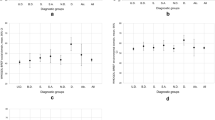Abstract
Quality of life (QOL) has become an important outcome measure for many disorders, including mental illness. The Lancashire Quality of Life Profile (LQOLP) was developed for use in operational contexts, and has been translated into several languages. It is in use in several European and North American community psychiatric services. The present paper addresses the questions: how easy is it to use?; how reliable is it?; do the results of the LQOLP vary by setting in a meaningful way?; how do the results co-vary with measures of clinical symptoms and social functioning?; how well does it measure change?; is it clinically useful? While most of the answers to these questions are favourable, there is a need for further research and development of the profile, in particular with reference to the consequences of the use of the profile as a routine monitoring instrument and the most appropriate form of statistical analysis in longitudinal data-sets.
Similar content being viewed by others
References
Arns PG, Linney JA (1995) Relating functional skills of severely mentally ill clients to subjective and societal benefits. Psychiatr Serv 46: 260–265
Baker F, Intagliata J (1982) Quality of life in the evaluation of community support systems. Eval Program Plann 5: 69–79
Birchwood M, Smith J, Cochrane R et al. (1990) The Social Functioning Scale: the development and validation of a scale of social adjustment for use in family intervention programmes with schizophrenic patients. Br J Psychiatry 157: 853–859
Bowling A (1991) Measuring health: a review of quality of life measurement scales. Open University Press, Milton Keynes
Bradburn N (1969) The structure of psychological well-being. Aldine, Chicago
Bridges K, Gage A, Oliver J et al (1993) Changes in social support and quality of life: a case study of a man with an enduring psychotic illness. Int J Soc Psychiatry 39: 142–151
Challis D, Davies B (1986) Case management in community care. Gower, Aldershot
Flanagan JC (1982) Measurement of quality of life: current state of the art. Arch Phys Med Rehabil 63: 56–59
Franklin JL, Simmons J, Solovitz B, Clemons JR, Miller GE (1986) Assessing quality of life of the mentally ill: three dimensional model. Eval Health Professions 9: 376–388
Gurin G, Veroff J, Feld S (1960) Americans view their mental health. Basic Books, New York
Hoffman K, Priebe S, Isermann M, Kaiser W (1996) Quality of life, needs and assessment of treatment in long-term hospitalized patients — part II of the Berlin De-Institutionalisation Study (in German). Psychiatr Praxis (in press)
Horst AP (1954) The estimation of immediate retest reliability. Educ Psychol Meas 14: 702–706
Huxley PJ (1995) Quality of Life. In: Muessen K, Tarrier N (eds) The handbook of social functioning in schizophrenia. Addison-Wesley, Reading, Mass.
Huxley PJ, Warner R, Berg T (1995) A controlled evaluation of the impact of clubhouse membership on quality of life and treatment utilization. J Psychosoc Rehab (submitted)
Kaiser W, Priebe S, Barr W, Hoffman K, Isermann M, Roder-Wanner U, Huxley PJ (1995) Subjective quality of life in schizophrenia in- and out-patient samples. Psychiatr Res (submitted)
Kaiser W, Priebe S, Hoffman K, Isermann (1996) Subjective quality of life in patients with chronic schizophrenia (in German). Nervenarzt (in press)
Lehman AF (1983) The effects of psychiatric symptoms on quality of life assessments among the chronic mentally ill. Eval Program Plann 6: 143–151
Marshall M (1994) How should we measure need? Concept and practice in the development of a standard schedule. Philosophy Psychol Psychiatry 1: 27–36
Marshall M, Lockwood A, Gath D (1995) Social services casemanagement for long-term mental disorders: a randomised controlled trial. Lancet 345: 409–412
Oliver JPJ, Huxley PJ, Bridges K, Mohamad H (1996) Quality of life and mental health services. Routledge, London
Priebe S, Gruyters T, Heinze M, Hoffman C, Jaekel A (1995) Subjective criteria for evaluation of psychiatric care — methods for assessment in research and routine care (in German). Psychiatr Praxis 22: 140–144
Rosenberg M (1965) Society and the adolescent self-image. Princeton University Press, Princeton
Spitzer WO, Dobson AJ (1981) Measuring the quality of life of cancer patients. J Chronic Dis 34: 585–597
Wilcox RR (1995) ANOVA: a paradigm for low power and misleading measures of effect size? Rev Educ Res 65: 51–77
Author information
Authors and Affiliations
Rights and permissions
About this article
Cite this article
Oliver, J.P.J., Huxley, P.J., Priebe, S. et al. Measuring the quality of life of severely mentally ill people using the Lancashire Quality of Life Profile. Soc Psychiatry Psychiatr Epidemiol 32, 76–83 (1997). https://doi.org/10.1007/BF00788924
Accepted:
Issue Date:
DOI: https://doi.org/10.1007/BF00788924




